 |
||
|
||
| ||
Today we start testing the new 4200 series of the NVIDIA GeForce4 Ti line. At the beginning of February 2002 NVIDIA announced only two cards of the new family - Ti 4400 and Ti 4600, but it was clear that the new model - Ti 4200 was also going to appear. The experienced users knew that the cards would be equipped with chips which didn't match for the senior series (Intel and AMD do the same thing). You shouldn't be afraid of it: it just means that the given die is not able to work stably at the specified frequency, and the latter is reduced to a certain level. And such chip is usually transferred into a lower gradation. But at that time (in February) nobody knew what frequencies the junior series would have. It became clear only in April: the Ti 4200 family will include cards the GPUs of which works at 250 MHz. Well, this is logical. The series differ by 25 MHz from each other. The Ti 4200 includes two cards (maybe it will get more later). The cards inside this family differ, first of all, in memory. 64 MHz cards didn't disappear when the GeForce4 Ti entered the market. One of the announced cards on the Ti 4200 will have 64 MBytes of DDR memory working at 250 (500) MHz. The other will be equipped with 128 MBytes of DDR memory working at 222 (444) MHz. But why is the frequency lower? Probably, to make the prices of the cards approximately equal. However, it turned out that the slower 128 MBytes cards are noticeably dearer than their 64 MBytes brothers which have a higher performance. Well, our tests will show whether such separation makes sense. The Ti 4200 based cards are long-awaited because they have capabilities of the GeForce4 Ti at much lower expenses. Especially it concerns the cards with the 64 MBytes memory (you will see this below). And now before we turn to the cards in question take a look at the list of reviews of the GeForce4 Ti cards published on our site. Theoretical materials and reviews of video cards which concern functional properties of the NVIDIA GeForce4 Ti GPU
Today we have both cards in our lab (with 64 MBytes and 128 MBytes of RAM). The cards are however from different manufacturers, though they both are based on the reference design. Leadtek and Gainward are well-known companies, and their products are valued not less than other brands (for example, ASUS). Cards
Leadtek WinFast A250LE 64 MBytes
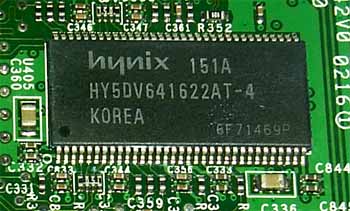 The card has an AGP x2/x4 interface, 64 MBytes DDR SDRAM located in 8 chips on both sides of the PCB. The Hynix 4ns memory chips correspond to 250(500) MHz (and the memory works at it). The GPU runs at 250 MHz which is standard for the Ti 4200. Gainward Powerpack Ultra/650 XP 128 MBytes
 The card has an AGP x2/x4 interface, 128 MBytes DDR SDRAM located in 8 chips on both sides of the PCB. The Samsung 4ns memory chips correspond to 250 (500) MHz. The card works at 250/222 (444) MHz. However, "Golden Sample" means that the card supports the Extremal mode. In this mode the frequency of operation is lifted up to 250/260 (520) MHz. Note that the chip's frequency doesn't get higher. So, the design of the PCB differs considerably (as compared with the GeForce4 Ti 4400/4600). The piece of textolite is shorter, and it is more similar to the RADEON 8500 cards. The way the memory chips are positioned is the same as on the RADEON 8500's PCB. The memory of the RADEON 8500, as you know, works at its rated frequency without being cooled. On the GeForce4 Ti 4200 64 MBytes the memory also works at the frequency rated for 4ns (250 (500) MHz) (and a cooler is not necessay at all). Secondly, the new design doesn't cut capabilities of the GeForce4 Ti in the nView part. Here we have the same VGA and DVI connectors, a TV-out, and possible VIVO support (there is space for the Philips 7108 on the reference design). Thirdly, both the 64 MBytes and the 128 MBytes cards will be based on a single design. Only the memory size will differ. Now let's take a look at peculiarities of both cards. As you can see, they differ also in the coolers. The coolers hide the GPU - GeForce4 Ti 4200: 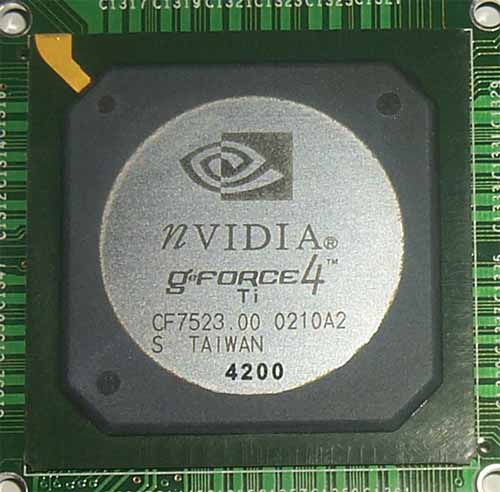  Both cards have processors with the official marking; they are produced in April 2002. The Gainward's card has Philips 7108 chip which means that it supports VIVO (Video-In Video-Out). The card comes with the respective adapter-splitter. By the way, the cards have the following accessoiries:
Overclocking
The overclocking results are really impressive! We get something intermediate between the Ti 4400 and 4600. I think that most Ti 4200 chips will be able to overclock so well. But as far as the memory is concerned, I don't know because it comes from different makers. However, the new design allowed the Samsung memory, which is usually difficult to overclock, to work at 280 (560) MHz when the rated speed for 4ns is 250 (500) MHz. Note:
Test system and driversTestbeds:
The test system was coupled with ViewSonic P810 (21") and ViewSonic P817 (21") monitors. In the tests we used NVIDIA's drivers of v28.90. VSync was off, S3TC was off. For the comparative analyses we used the following cards:
Test resultsThe 2D quality is excellent, you can play comfortably at 1600x1200x85 Hz. Remember that we used the ViewSonic P817 monitor connected to the card via the BNC. For estimation of 3D quality we used:
The test was carried out in a 32-bit color mode. For each test we have two diagrams which group the results differently (for processors and for video cards). For comparison of the working speeds of the 64 MBytes and 128 MBytes cards at equal frequencies the diagrams also show results of the Gainward Powerpack Ultra/650 XP 128 MBytes card the memory of which is overclocked up to 250 (500) MHz. 3D Mark2001 SEGame1 Low Details
 The first thing that catches my eye is that the
GeForce4 Ti 4200 128 MBytes is not much better than the RADEON 8500
128 MBytes (the difference is almost lacking in 1600x1200). Besides,
if we compare speeds of both cards based on the Ti 4200 at the same
frequency (the lilac and hatched bars) we will see that the 128
MBytes card has some advantage. It is already not a GeForce3 Ti
200 card with 64 or 128 MBytes... 1024x768

 This test is very processor-dependent, that is
why on the PIII-1000 MHz almost all the cards go on a par. Such
situation also occurred earlier (see the list above). 1280x1024

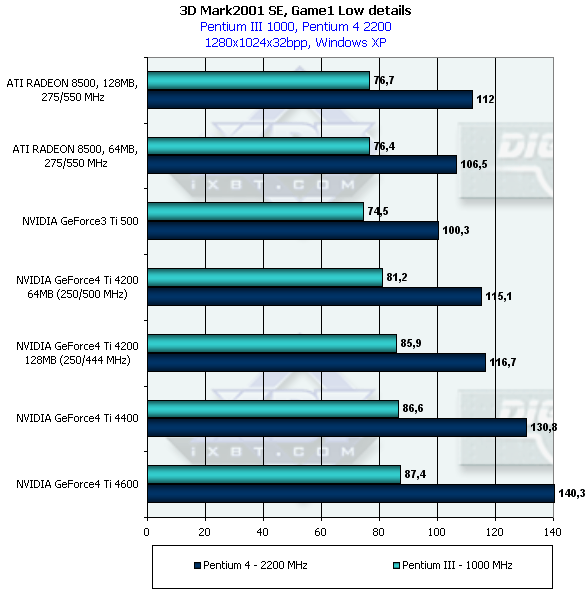 Here the GeForce4 Ti 4200 128 MBytes works faster
than the 64 MBytes model despite the lower memory frequencies. 1600x1200

 In this resolution the memory frequency, as you can see, is more important. Game2 Low Details
 The 128 MBytes Ti 4200 running at the same frequency
as the 64 MBytes card has a slight advantage. 1024x768

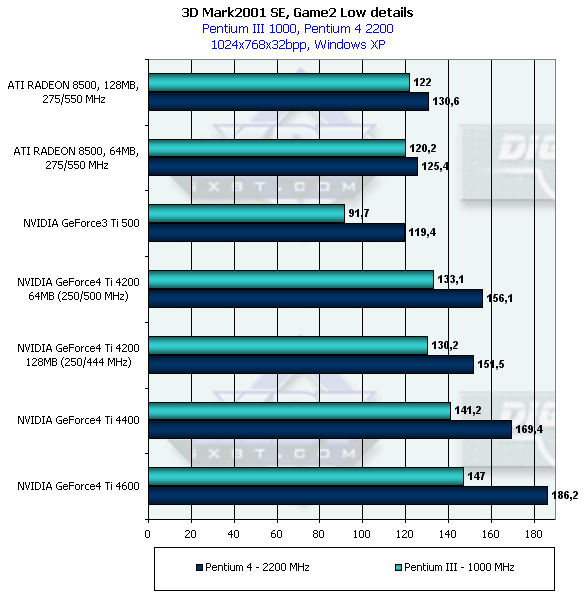 This test depends on a processor least of all,
that is why the layout of the cards is the same for the Pentium4
and for Pentium III platforms. Again, the new cards take an intermediate
position between the RADEON 8500 128 MBytes and GeForce4 Ti 4400.
1280x1024
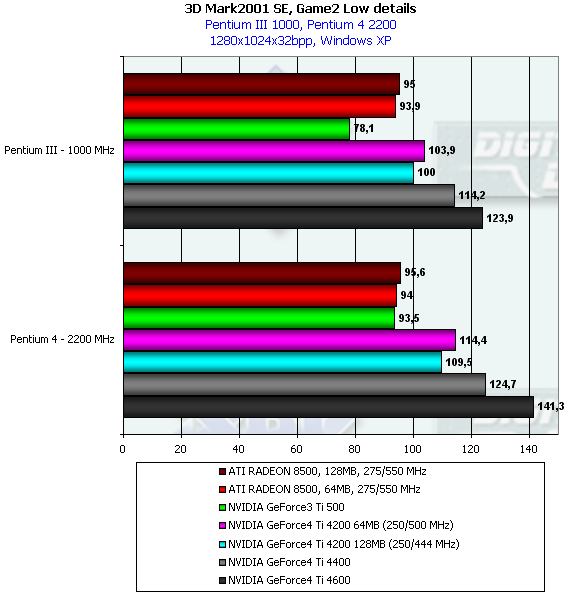

1600x1200

 As the resolution increases the difference in the test results between the Pentium III and Pentium 4 platforms falls down. Game3 Low Details
 This test is very tough for the GeForce4 Ti 4200,
and performance of the 128 MBytes card is almost equal to the ATI
RADEON 8500 128 MBytes. This card still outscores the 64 MBytes
GeForce4 Ti 4200 although they work at the equal frequencies. 1024x768
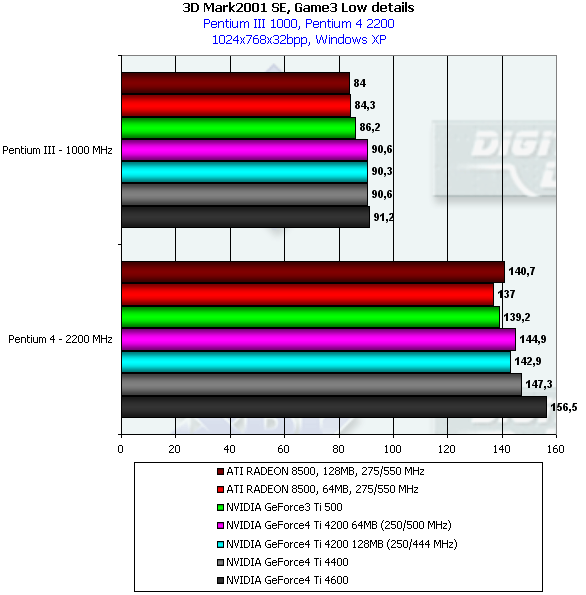
 This test depends much on the processor, that is
why all the cards score equal results on the Pentium III. 1280x1024
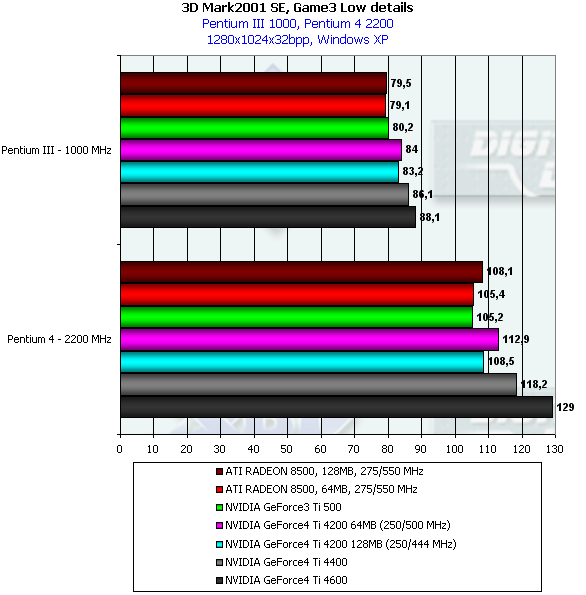
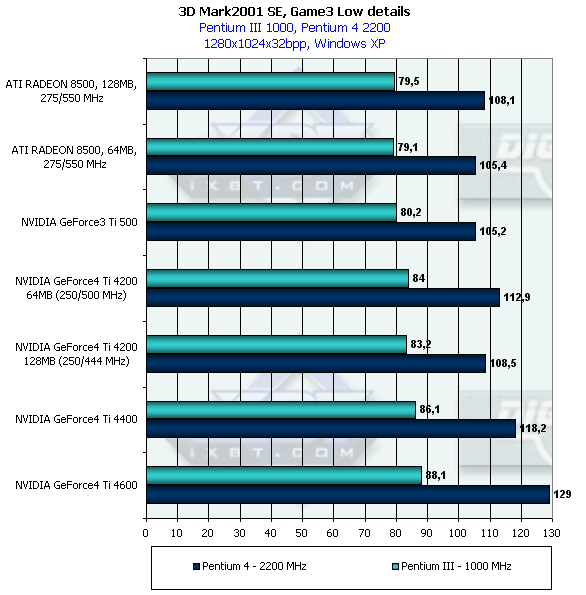 Note that performance of the GeForce4 Ti 4200 128
MBytes is almost equal to the speed of the RADEON 8500 128 MBytes.
1600x1200

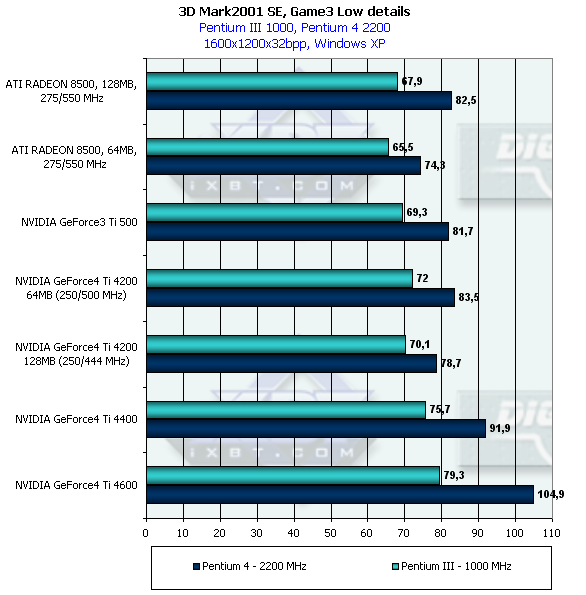 And in this resolution the RADEON 8500 128 MBytes outedges the Ti 4200 128 MBytes on the Pentium 4 platform. Game4
 This test is really sad for fans of NVIDIA products,
here the RADEON 8500 is an impeccable leader. 128 MBytes of memory
of the Ti 4200 card provides some advantage as compared with the
64 MBytes card at the same frequency. 1024x768
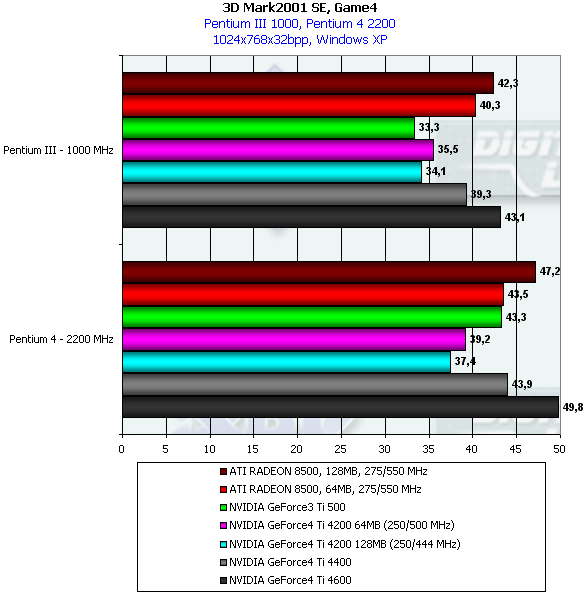
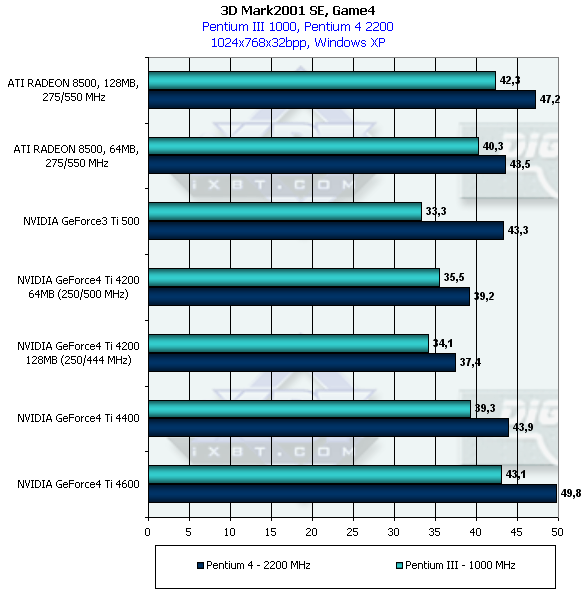 This test doesn't depend much on a processor, although
the absolute FPS is quite low. 1280x1024
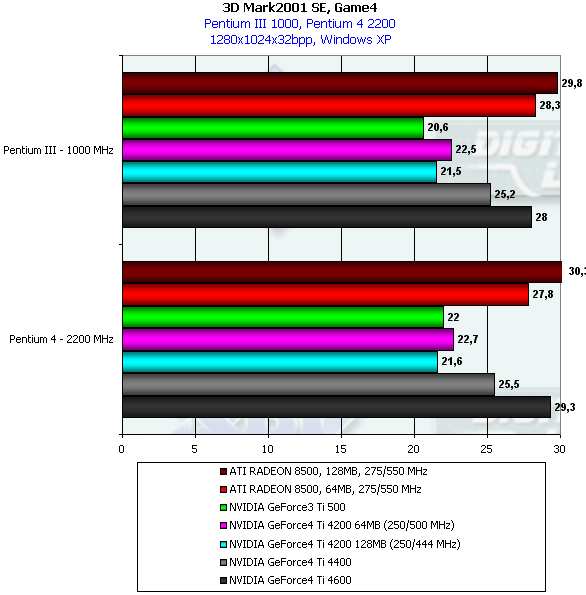
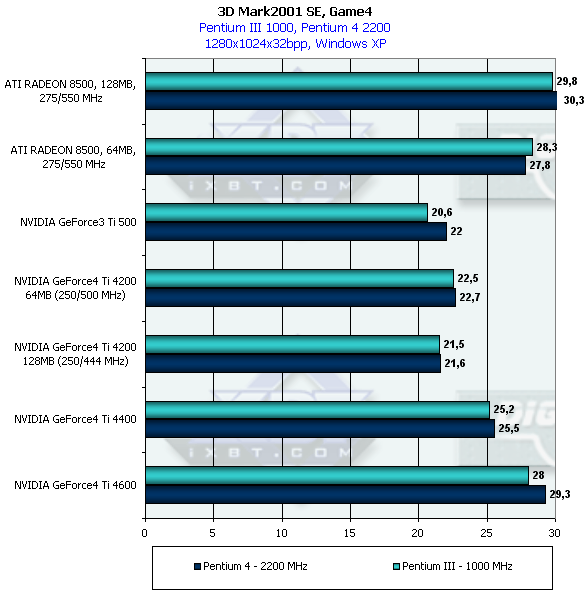
1600x1200
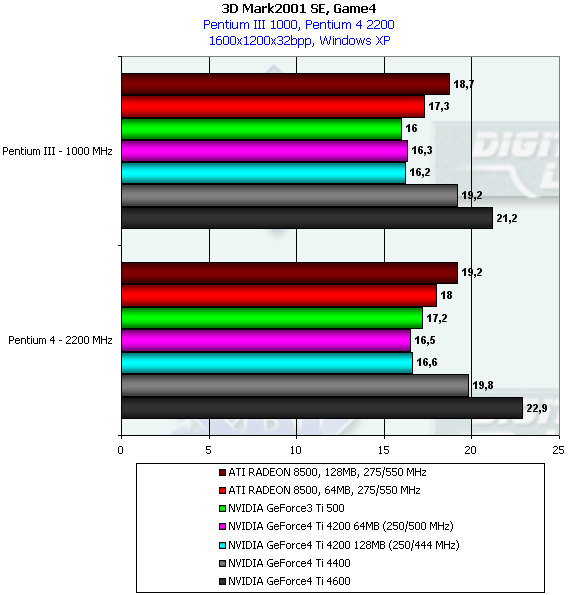
 As the resolution grows up the difference between the test results on different platforms decreases, as well as the advantage of the RADEON 8500. The fillrate is rather low. Though the GeForce4 Ti 4200 based cards are still behind the RADEON 8500. 3D MARKS
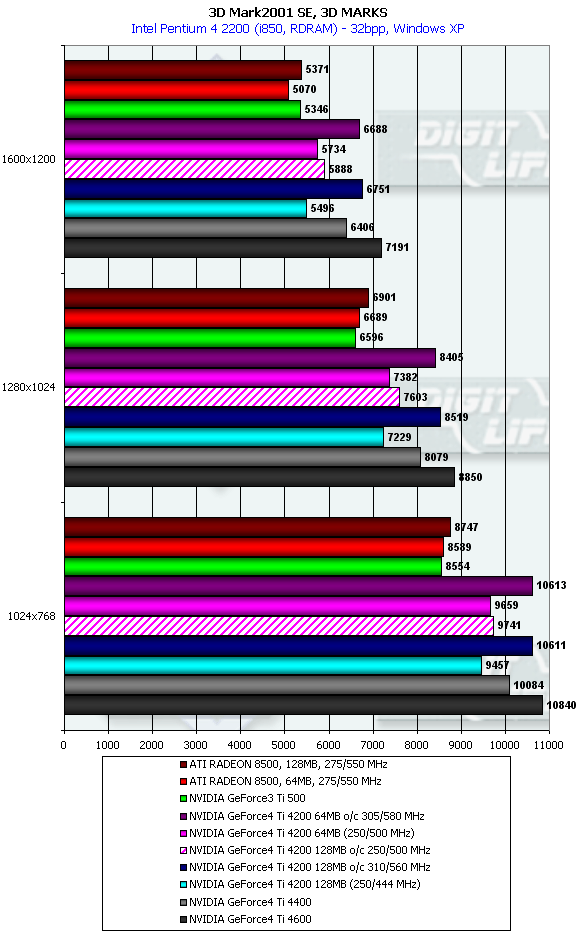 The GeForce4 Ti 4200 128 MBytes performs worse than the 64 MBytes model until the frequency of the former is lifted up to 250 MHz. As the resolution grows up the difference between this card and the RADEON 8500 reduces, though the GeForce4 Ti 4200 is an undoubted leader. Especially, if we take into account the current prices - around $210-220 for the 128 MBytes card and $160-180 for the 64 MBytes one. Do not worry that we carry out only the 3DMark2001 tests. Soon we will review more such cards (we will also include other tests); besides, our April 3Digest contains the test results of the 128 MBytes card, and the scores of the 64 MBytes model will be published in the next issue. A little of beautiful graphicsTaking into account the prices (that were shown
above) and the GeForce3 Ti 200 card which is available at $120 and
cheaper, I can say that pixel shaders have at last entered the mass
market :-) Just look at the screenshots of the new game called Elder
Scrolls III: Morrowind: ConclusionHaving analyzed operation of the GeForce4 Ti 4200 I can say that this is a successful solution. First of all, we get a performance higher than that of the GeForce3 Ti 500 at a more pleasant price; secondly, there are much more cards in the $150-200 segment than in the more expensive sector, and the great amounts of cards will soon result in price cutting. I think that at the beginning of June all cards based on this GPU will be cheaper than $200. And today, taking into account the prices, I can say that it's better to take the 64 MBytes cards on the GeForce4 Ti 4200 (but remember that the situation may change very soon). First because not more than 5% of users can overclock cards, that is why the 128 MBytes cards will work at their rated frequencies in most cases (which are lower than those of the 64 MBytes samples). Besides, the experience shows that the 128 MBytes Ti 200 cards will be equipped with the Samsung modules which do not have a brilliant overclocking potential; while the 64 MBytes Ti 4200 cads will come with Hynix or EtronTech memory, which are good at overclocking. But it concerns only overclockers. Let's summarize everything:
For more complete characteristics of video cards of this and other classes see our 3Digest. Highs:
Lows:
Write a comment below. No registration needed!
|
Platform · Video · Multimedia · Mobile · Other || About us & Privacy policy · Twitter · Facebook Copyright © Byrds Research & Publishing, Ltd., 1997–2011. All rights reserved. |